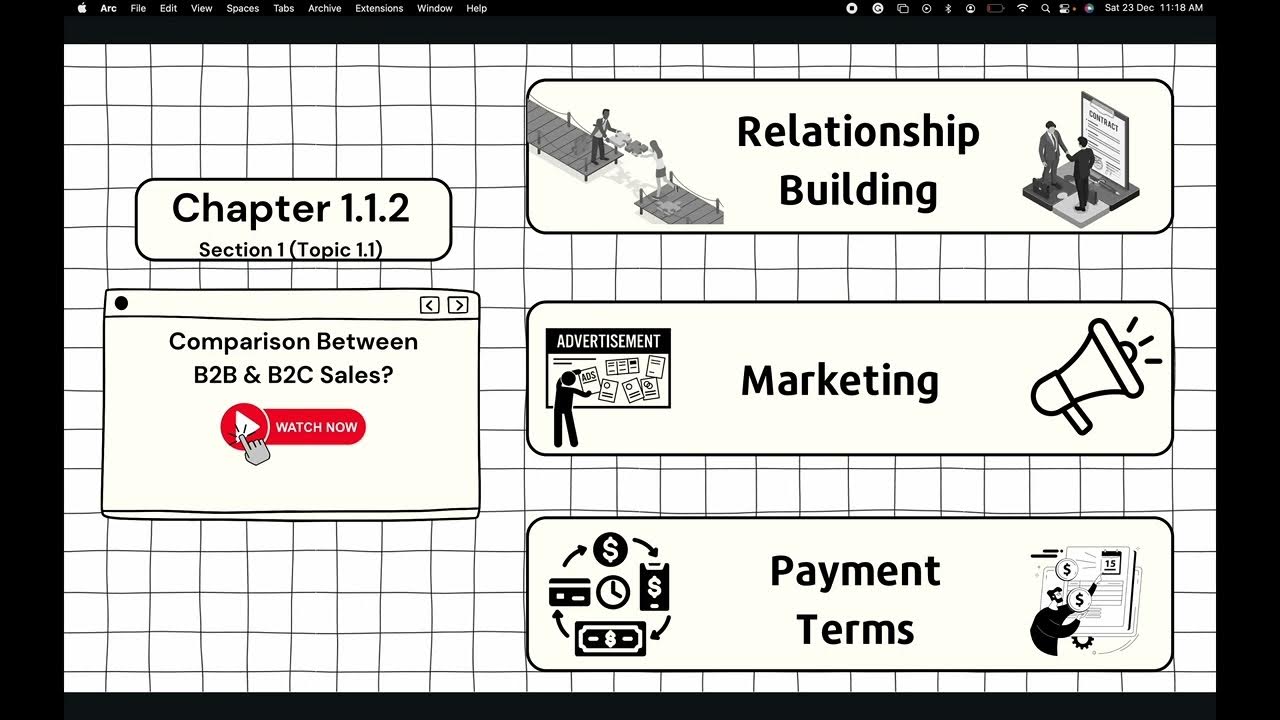Marketing
Summary
TLDRIn this video, Morten Kille Nikolajsen, Purchasing and Marketing Director at Davidsen, shares insights into the company's approach to business in both B2B and B2C sectors. He discusses the differences in how customers engage with their online and in-store platforms, highlighting the role of customer segmentation in providing tailored services. He elaborates on the buying behavior of professional versus private customers, the company's focus on quality, and how they differentiate themselves through customer service and advice. He also explores pricing strategies, market trends, and the importance of local decision-making in maintaining competitiveness.
Takeaways
- 😀 The business operates in both B2B and B2C segments, with different approaches for online and in-store offerings.
- 😀 B2B customers primarily use the online platform for gathering information and placing orders, while B2C customers are more transaction-driven.
- 😀 In-store shopping for both B2B and B2C is similar, involving finding products and either purchasing them directly or opting for home delivery.
- 😀 Customer segmentation at Davidsen includes both professional customers (e.g., contractors and construction companies) and private consumers who enjoy DIY projects.
- 😀 The professional customers value local presence, knowledgeable salespeople, strong product selection, and reliable logistics for large and heavy construction goods.
- 😀 Private customers often start their purchasing journey online, comparing products and prices, and may either proceed with an online purchase or visit the store for pickup.
- 😀 The store experience is focused on providing quick service with a smile, but the level of product knowledge required differs between professional and private customers.
- 😀 Davidsen's product quality is positioned as medium to high, given the importance of durability and reliability in construction products, which can have long-lasting impacts on building projects.
- 😀 Pricing strategies vary between B2B and B2C segments, with B2C offering competitive pricing and discounts via a loyalty club, while B2B customers may receive tailored offers based on project size and ongoing agreements.
- 😀 Davidsen faces challenges with price cannibalization during promotional campaigns, as discounted products might reduce profit margins while attracting new customers.
- 😀 Market information is crucial for the business, gathered through sales teams, supplier insights, and market reports, and is reviewed regularly to ensure pricing strategies remain competitive.
Q & A
What is the primary difference between Davidsen's B2B and B2C offerings?
-For B2B, Davidsen's online platform is seen as a service tool to provide information and place orders. In contrast, the B2C platform is more transactional, focusing on product selection, adding items to a cart, and completing the purchase process.
How does Davidsen tailor its services to meet the needs of different customer segments?
-Davidsen segments its customers into B2B (professional customers like carpenters, masons, and contractors) and B2C (DIY enthusiasts, hobbyists, and gardening customers). The company offers specialized services for each, like in-store assistance for B2C and technical advice for B2B clients.
How does the customer experience differ when shopping online versus in-store at Davidsen?
-Online shopping offers more of a service-based experience, where customers gather information and place orders. In-store, customers find products on shelves, and the shopping process involves picking items and checking out, with the option for delivery after purchase.
What role does customer service play in Davidsen’s approach to handling different customer types?
-Customer service is crucial for both B2B and B2C customers. For B2B, the focus is on knowledgeable salespeople who provide tailored advice and services. For B2C, customer service aims to educate and assist, ensuring customers make informed product decisions.
Why does Davidsen focus on offering medium to high-quality products in the construction market?
-Davidsen emphasizes medium to high-quality products because construction materials need to be durable and reliable. Poor-quality products can lead to costly repairs or replacements, which outweigh the initial cost savings, especially in long-term projects with warranties.
How does Davidsen handle pricing for different customer types (B2B and B2C)?
-For B2C, Davidsen maintains competitive and consistent pricing, offering customer clubs for discounts and running promotional campaigns. For B2B, pricing is more flexible, with offers and project-based pricing to ensure competitiveness in larger, more complex orders.
How does Davidsen handle its product range and pricing strategy in the market?
-Davidsen offers a broad product range, focusing on quality and customer service rather than just low prices. While the company may not always be the cheapest, it aims to offer competitive prices, especially by including value-added services like warranties, delivery, and advice.
What are the main purchasing behaviors of professional customers versus private customers at Davidsen?
-Professional customers tend to make repeated purchases based on established relationships with Davidsen, seeking local presence, skilled advisors, and strong logistics. Private customers are more price-sensitive, often starting their shopping online, comparing prices, and sometimes opting for delivery or in-store pickup.
How does Davidsen monitor and adjust its pricing strategies based on competition?
-Davidsen monitors competitors' pricing through market reports, competitor pricing analysis, and sales data from their own sales team. The company adjusts its pricing in response to market changes, using local decision-making to ensure competitiveness and profitability.
What role do salespeople play in Davidsen’s overall strategy for customer engagement?
-Salespeople at Davidsen play a key role by providing valuable market insights, offering advice to customers, and ensuring that the company remains competitive in terms of pricing and product offerings. Their feedback helps adjust pricing strategies and improve product selection.
Outlines

This section is available to paid users only. Please upgrade to access this part.
Upgrade NowMindmap

This section is available to paid users only. Please upgrade to access this part.
Upgrade NowKeywords

This section is available to paid users only. Please upgrade to access this part.
Upgrade NowHighlights

This section is available to paid users only. Please upgrade to access this part.
Upgrade NowTranscripts

This section is available to paid users only. Please upgrade to access this part.
Upgrade Now5.0 / 5 (0 votes)





